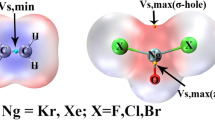Abstract
The nature of the Ga-Ga bonding in Na2[Arx*GaGaArx*] (Arx* = C6H3-2,6-(C6H5)2) has been investigated and compared with that of in H2[Arx*GaGaArx*] using electron localization function (ELF) and orbital analysis. The calculation results show that in Na2[Arx*GaGaArx*], the Ga-Ga interaction is a non-classical triple bond, the heart of Na2[Arx*GaGaArx*] is the Ga2Na2 cluster rather than a simple Ga-Ga bond, and the contribution of the sodium atoms to the short Ga-Ga bond length is considerable. As the two sodium atoms are substituted by two hydrogen atoms, the Ga-Ga bond is replaced by two 3-center, 2-electron (3c-2e) Ga-H-Ga covalent bridged bonding.
Similar content being viewed by others
References
Wang YZ, Robinson GH. Organometallics of the group 13 M-M bond (M = Al, Ga, In) and the concept of metalloaromaticity. Organometallics. 2007, 26: 2–11
Ponec R, Yuzhakov G, Gironés X, Frenking G. Chemical structures from the analysis of domain-averaged Fermi holes. The nature of Ga-Ga bonding in PhGaGaPh2− and (PhGaGaPh)Na2. Organometallics. 2004, 23: 1790–1796
Power PP. Homonuclear multiple bonding in heavier main group elements. J Chem Soc, Dalton Trans, 1998, 2939–2951
Power PP. π-Bonding and the lone pair effect in multiple bonds between heavier main group elements. Chem Rev, 1999, 99: 3463–3503
Weidenbruch M. Some recent advances in the chemistry of silicon and its homologues in low coordination states. J Organomet Chem, 2002, 646: 39–52
Uhl W. The reactivity of organoelement compounds with aluminium-aluminium, gallium-gallium and indium-indium bonds. Coord Chem Rev, 1997, 163: 1–32
Linti G, Schnoöckel H. Low valent aluminum and gallium compounds — structural variety and coordination modes to transition metal fragments. Coord Chem Rev, 2000, 206–207: 285–319
Robinson GH. Gallanes, gallenes, cyclogallenes, and gallynes: Organometallic chemistry about the gallium-gallium Bond. Acc Chem Rev, 1999, 32: 773–782
Weidenbruch M. Triple bonds of the heavy main-group elements: Acetylene and alkylidyne analogues of Group 14. Angew Chem, 2003, 42: 2222–2224
Su JR, Li XW, Crittendon RC, Robinson GH. How short is a -Ga≡Ga-triple bond? Synthesis and molecular structure of Na2[Mes*2C6H3-GaGaC6H3 Mes*2] (Mes* = 2,6-bis(2,4,6-i-Pr3C6H2): The first gallyne. J Am Chem Soc, 1997, 119: 5471–5472
Takagi N, Schmidt MW, Nagase S. Ga-Ga multiple bond in Na2[Ar*GaGaAr*] (Ar* = C6H3-2,6-(C6H2-2,4,6-i-Pr3)2). Organometallics, 2001, 20: 1646–1651
King RB, Robinson GH. Analogies between Group 13 metal clusters in organometallic and intermetallic structures. J Organomet Chem, 2000, 597: 54–60
Downs AJ. Recent advances in the chemistry of the Group 13 metals: Hydride derivatives and compounds involving multiply bonded Group 13 metal atoms. Coord Chem Rev, 1999, 189: 59–100
Dagani RA. Gallium triple bonds under fire. Chem Eng News, 1998, 76: 31–33
Molina JM, Dobado JA, Heard GL, Bader RFW, Sundberg MR. Recognizing a triple bond between main group atoms. Theor Chem Acc, 2001, 150: 365–371
Xie YM, Grev RS, Gu J, Schaefer III HF, Schleyer PvR, Su J, Li XW, Robinson GH. The nature of the gallium-gallium triple bond. J Am Chem Soc, 1998, 120: 3773–3880
Bytheway I, Lin ZY. Understanding nonlinearity in multiply-bonded digallium molecules. J Am Chem Soc, 1998, 120: 12133–121134
Cotton FA, Cowley AH, Feng X. The use of density functional theory to understand and predict structures and bonding in main group compounds with multiple bonds. J Am Chem Soc, 1998, 120: 1795–1799
Becke AD, Edgecombe KE. A simple measure of electron localization in atomic and molecular systems. J Chem Phys, 1990, 92: 5387–5403
Silvi B, Savin A. Classification of chemical bonds based on topological analysis of electron localization functions. Nature, 1994, 371: 683–686
Savin A, Nesper R, Wengert S, Fassler T. ELF: The electron localization function. Angew Chem Int Ed, 1997, 36: 1808–1832
Silvi B. The synaptic order: A key concept to understand multicenter bonding. J Mol Struct, 2002, 4614: 3–10
Häussermann U, Wengert S, Nesper R. Unequivocal partitioning of crystal structures, exemplified by intermetallic phases containing aluminium. Angew Chem Int Ed, 1994, 33: 2073–2076
Sorkin A, Truhlar DG, Amin EA. Energies, geometries, and charge distributions of Zn molecules, clusters, and biocenters from coupled cluster, density functional, and neglect of diatomic differential overlap models. J Chem Theory Comput, 2009, 5: 1254–1265
Gaussian 03, Revision D. 01. Wallingford CT: Gaussian, Inc., 2004
Noury S, Krokidis X, Fuster F, Silvi B. TopMod Package. Paris: Universite Pierre et. Marie Curie, 1997
Noury S, Krokidis X, Fuster F, Silvi B. Computational tools for the electron localization function topological analysis. Comp Chem, 1999, 23: 597–604
Cotton FA, Cowley AH, Feng XJ. The use of density functional theory to understand and predict structures and bonding in main group compounds with multiple bonds. J Am Chem Soc, 1998, 120: 1795–1799
Macchia GL, Gagliardi L, Power PP, Brynda M. Large differences in secondary metal-arene interactions in the transition-metal dimers ArMMAr (Ar = terphenyl; M = Cr, Fe, or Co): Implications for Cr-Cr quintuple bonding. J Am Chem Soc, 2008, 130: 5104–5114
Author information
Authors and Affiliations
Corresponding author
Electronic supplementary material
Rights and permissions
About this article
Cite this article
Sun, J., Meng, L., Zheng, S. et al. Nature of the Ga-Ga bonding in Na2[Arx*GaGaArx*] (Arx* = C6H3-2,6-(C6H5)2): Electron localization function analysis. Sci. China Chem. 55, 1370–1376 (2012). https://doi.org/10.1007/s11426-012-4640-8
Received:
Accepted:
Published:
Issue Date:
DOI: https://doi.org/10.1007/s11426-012-4640-8




